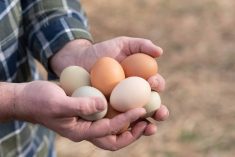Before I get into my first column of 2023, I’d like to wish you a Happy New Year! I hope 2023 is a great year for all.
That said, what a wild ride 2022 was. The high commodity prices and the promise of a new growing season after the 2021 drought had us all feeling cautiously optimistic early in 2022. Then all heck broke loose.
We watched in disbelief at the invasion of Ukraine by Russia, skyrocketing ag input costs, increased production costs, worsening supply chain gaps and disruptions, avian influenza outbreaks, extreme volatility in commodity prices, flooding in some regions and drought in others, and the devastation many East Coast sectors endured from Hurricane Fiona — and these were only the biggest of the year’s shocks.
Read Also

Health hazards are often overlooked risks on the farm
While quite different from the dangers posed by farm machinery, hazards such as loud noise or sun exposure require the same proactive attention, the Canadian Agricultural Safety Association says.
Also in 2022, we experienced the highest CPI (consumer price index) inflation rate in 40 years in June, reaching 8.1 per cent year over year. In early December, the Bank of Canada increased its target for the overnight interest rate to 4.25 per cent. And we’ve all experienced sticker shock at the price of food, due to that record inflation.
According to Statistics Canada, price increases for food sold in stores on a year-over-year basis grew more than 10 per cent in August, September and October. In September, yearly price increases for food purchased in stores rose at the fastest pace (11.4 per cent) since 1981, remaining at 11 per cent in October.
Heading into 2023, we’re all concerned about high inflation rates, increasing interest rates and the “R” word. However, it’s not all doom and gloom. Experts are calling for a mild recession and say it shouldn’t be as severe as the one in 2008 or during the outset of the pandemic but a “moderate” market correction.
In a July report, J.P. Gervais, vice-president and chief economist at Farm Credit Canada (FCC), said Canadian farmers are in a good position to meet the challenges 2023 may present.
“Farming under inflation is nothing new, yet each inflationary period is unique,” he said. “A critical feature of the current inflationary phase is the growth in farm revenues. Global food demand continues to be robust while supply is limited in many producing countries. Canadian agriculture is in a good spot to weather inflationary pressures and higher interest rates. Yet, operations will need to adjust to farming under high interest rates — a situation unlike the one experienced for the last 15 years.
“Operations should run various assumptions with regards to commodity and farm input prices, yields (and) interest rates to understand their financial risk exposure, and seek different strategies to mitigate risk if they find situations that exceed their risk tolerance.”
According to Martha Roberts, a FCC economics editor, price volatility in agricultural commodities has calmed as we head into winter, which means prices could be “more stable through to spring.”
There’s been other positives. According to Roberts, farm receipts were up 7.3 per cent in the first nine months of this year when compared with last year. Many regions experienced a much better crop in 2022 in the Prairies, so receipts should climb higher this quarter (it is December at the time of writing). Also, borrowing costs overall are about to “plateau” for most of 2023 and overall farm input inflation “should moderate considerably,” she said in a December report.
For those of you thinking about buying farm equipment, the strong demand we’ve experienced since the pandemic began will continue in 2023 and 2024, “as the market weathers rising interest rates and a weakening Canadian dollar,” according to FCC’s farm equipment market outlook.
“Producers will benefit from strategic planning as inventory levels for farm equipment remain below pre-pandemic levels, something we expect could continue through 2024,” said Gervais, noting tractor inventory levels are down 42 per cent and combines are down 47 per cent from the five-year average. “This equipment demand is supported by strong farm cash receipts, while inventory is hampered by the supply chain disruptions we saw over the past two years.”
Shutdowns due to the pandemic and a short supply of new equipment and parts also increased demand in used equipment markets. However, it’s expected manufacturers will increase production of new equipment and the used market will moderate.
The strength of the Canadian dollar has weakened against the U.S. dollar. This has a direct effect on new equipment prices, pushing them higher, since most new tractors and combines sold in this country are made in the United States.
For those of you considering adding new ag technologies to your operation, I’d follow Joy Agnew’s guidelines for navigating ag tech. Agnew, who is the associate vice-president of applied research at Olds College, offered some advice to farmers and agronomists at Saskatchewan Agriculture’s Agronomy Research Update in December. Some of those recommendations included the following:
- There are countless new technology options becoming available. The best ones are those that support decision-making, improve efficiencies and help mitigate risk.
- The “value” of a technology or practice needs to be assessed on a case-by-case basis based on your situation, priorities and expectations.
- Consider more than just cost in your assessment of the value or payback of technologies and tools.
You know what to do to navigate higher interest rates and inflation. You’ve already come through a pandemic and black swan event — 2023 should be a doddle for you. However, it’s a great time to review your farm’s short- and long-term business management plans and to carry out a financial risk assessment.
Also, make strategic equipment purchases and base ag tech choices on those that aid decision-making, create efficiencies on your farm and decrease risk. Evaluate ag technologies on a case-by-case basis and consider factors beyond cost when assigning values to those technologies like peace of mind, for one.
Spreading out your risk, making thoughtful purchases and leaning into your operation’s long- and short-term business management plans will carry you through choppy waters in 2023 and beyond.
On a completely different topic, I’d like to thank those of you who have reached out to me over the year with your topic suggestions and your own stories about farming and living in the Prairies. Recently, in our November issue of Grainews, I asked you about your wartime remembrances in my column. A lovely gentleman from Alberta called Grainews to share his wartime recollection from 1942. That memoir appears on the next page along with another memoir from a Saskatchewan farmer and writer. What a great way to kick off the new year than a couple of heartwarming stories from you, our readers!
All the best in 2023,
Kari
















